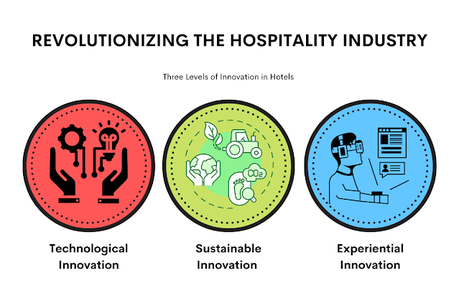
Rapid technology improvements and shifting customer expectations are driving a revolutionary phase in the hotel sector. Hotels are adopting cutting-edge solutions that improve guest experiences and optimize operations to remain competitive and satisfy the changing needs of travelers. This thorough manual explores the three innovation levels that areinnovation in hospitality industryand provides hotel operators with useful information, real-world examples, and implementable tactics.
Table of Contents
Introduction
Level 1: Technological Innovation
Smart Room Technology
Automation and AI
Data-Driven Personalization
Level 2: Sustainable Innovation
Eco-Friendly Practices
Green Certifications and Standards
Sustainable Design
Level 3: Experiential Innovation
Unique Guest Experiences
Local and Authentic Experiences
Introduction
Once known for its conventional services and comforts, the hotel sector is now at the forefront of innovation. Hotels are under pressure to implement new technology and techniques as guest preferences shift toward personalized experiences and environmentally conscientious practices. The three main types ofhotel innovation that are changing the industry are technological, sustainable, and experiential, all of which are covered in this article. To match visitor expectations, improve operational efficiency, and maintain an advantage in a cutthroat market, each level is essential.

Level 1: Technological Innovation
Many of the developments in the hotel business are the result of technological advancement. These developments, which range from data-driven customization to smart room technology, are changing the way hotel's function and engage with their visitors.
Smart Room Technology
The term "smart room technology" describes the incorporation of cutting-edge equipment and systems into hotel rooms to improve the comfort and convenience of visitors. This comprises:
Voice-Activated Controls: Guests can use voice commands to operate the lighting, heating, and entertainment systems with devices such as Google Home and Amazon Alexa.
Smart Thermostats: By adjusting the temperature in a space according to visitor preferences and occupancy, intelligent thermostats increase energy efficiency.
Appliances with Internet of Things (IoT) capabilities: IoT technology enables fixtures and appliances to talk to one another, resulting in a flawless visitor experience.
Automation and AI
Hotel operations are transforming thanks to automation and artificial intelligence (AI), which improves service quality and streamlines procedures. Important uses consist of:
Virtual assistants and chatbots: AI-driven chatbots improve response times and customer satisfaction by answering questions about reservations, offering information, and helping with service requests.
Robotic Process Automation: By automating monotonous jobs like housekeeping requests and check-in/check-out procedures, robots free up staff members to concentrate on individualized guest encounters.
Predictive analytics: To improve the overall visitor experience, AI evaluates visitor data to anticipate preferences and provide personalized recommendations.
Data-Driven Personalization
Utilizing visitor data, data-driven personalization generates unique offerings and experiences. Methods consist of:
Guest profiles: Hotels can customize services and promotions to each guest's specific needs by gathering information on guest preferences and behavior.
Dynamic Pricing: Data analysis enables real-time hotel rate adjustments based on demand, rival pricing, and other variables.
Targeted marketing: Using visitor information, customized marketing campaigns present pertinent offers and messaging that boost interaction and conversion rates.

Level 2: Sustainable Innovation
The hospitality sector is focusing on sustainability to lessen their environmental effect and luring environmentally conscientious tourists. Design concepts, eco-friendly certifications, and practices are all part of sustainable innovation.
Eco-Friendly Practices
Hotels are reducing their environmental impact by implementing a range of eco-friendly measures. Among them are:
Energy Efficiency: Lowering energy expenses and consumption can be achieved by installing energy-efficient heating, cooling, and lighting systems.
Water Conservation: Reducing water usage and energy costs can be achieved by installing low-flow fixtures and water-saving technologies.
Waste Reduction: Recycling, composting, and cutting less on single-use plastics are all initiatives that help reduce waste and promote sustainability.
Green Certifications and Standards
To demonstrate a dedication to sustainability, one must obtain green certifications and uphold environmental norms. Important certifications consist of:
Buildings that adhere to strict environmental requirements for energy, water, and material consumption are recognized by LEED (Leadership in Energy and Environmental Design).
Green Key: Given to lodging establishments that practice sustainability and show care for the environment.
EarthCheck: Offers certification to lodging establishments that adhere to international sustainability standards and best practices.
Sustainable Design
The goal of sustainable design principles is to create hotel structures that are both resource- and environmentally efficient. This comprises:
Use of Sustainable Materials: Reusing renewable materials in building and interior design lessens its negative effects on the environment.
Energy-Efficient Design: Increasing natural light and optimizing energy utilization in a building's design helps reduce energy use.
Green Roofs and Landscaping: Using sustainable landscaping techniques and green roofs increases biodiversity and offers natural insulation.

Level 3: Experiential Innovation
The core of experiential innovation is giving visitors one-of-a-kind and unforgettable experiences. At this stage of innovation, local experiences, tailored amenities, and individualized service offerings are the main points of emphasis.
Unique Guest Experiences
Offering distinctive guest experiences that go beyond standard lodging is a priority for hotels these days. This comprises:
Immersion Activities: Enhancing the guest experience is possible by providing special activities like adventure trips, cooking courses, and cultural events.
Personalized Services: Catering to individual tastes in spa treatments, dining options, and lodging amenities increases the level of pleasure from guests.
Themed Rooms & Suites: Creating unique and unforgettable stays for guests is achieved by designing rooms with themes or features.
Customized Service Offerings
Tailored service offersaccommodate the unique needs and interests of each visitor. Among the strategies are:
Pre-Arrival Surveys: Gathering preferences from guests ahead of time enables hotels to provide individualized services and amenities.
On-Demand Services: Giving visitors the ability to ask for extra services or adjustments while they are visiting improves convenience and happiness.
Create loyalty programs that provide individualized awards and recognition according to the actions and preferences of your guests.
Local and Authentic Experiences
Hotels are putting more of an emphasis on genuine, local experiences to help visitors get to know the local way of life. This comprises:
Local Partnerships: Working together with nearby companies, creators, and chefs to provide visitors with genuine area goods and experiences.
Providing opportunities for visitors to participate in regional customs, celebrations, and events is known as cultural immersion.
Farm-to-Table eating: Providing eating options that highlight regional cuisine and use foods that are sourced locally.

